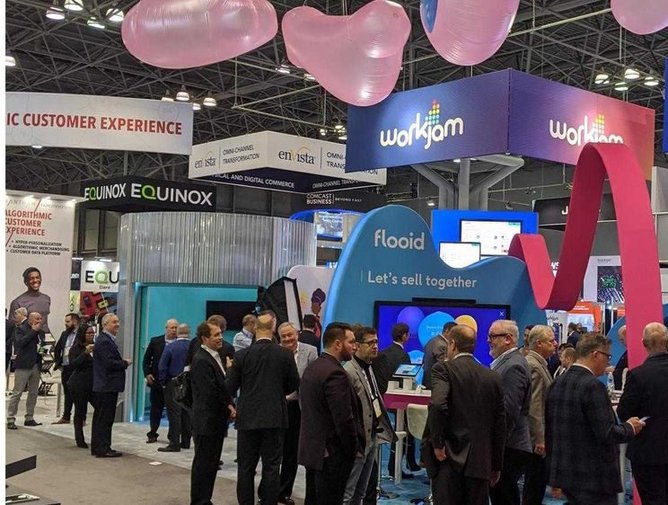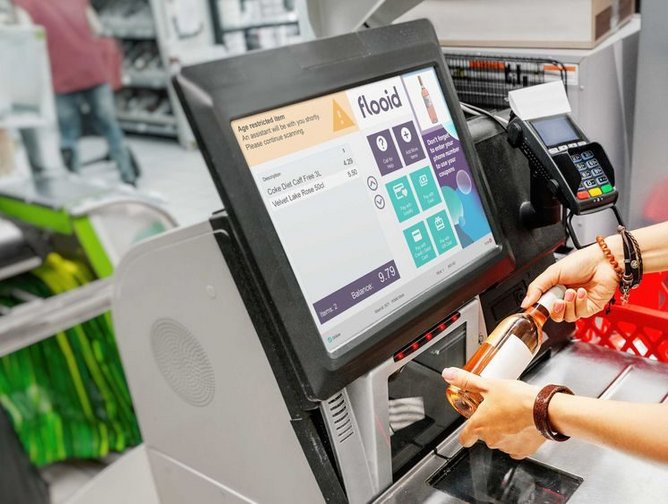A year ago, give or take, PCMS rebranded as Flooid. But the decision to change the name of the company was far from a whim. A slew of vendors in the point-of-sale market had initial-based names, and PCMS wanted to break free from being clubbed in with POS-only providers. As Flooid was born out of PCMS’ ashes, the board was intent on getting the message out that while POS was part of it’s offering, it wasn’t the whole package.
“We felt doing a rebrand would create a bit of noise in the market,” explains Flooid CEO EMEA Martyn Osborne. “Point of sale is just one of the things we provide to retailers, but we’ve always provided a slightly different mix of capabilities beyond just POS. We were able to amplify some of the other things we do.”
Osborne, who’s been with the business for 24 years, took the helm at the time of the rebrand. His roles in product development and operations mean he’s been heavily invested in the operational side of the business.
Essential retail
It hasn’t necessarily all been a smooth ride. Many of Flooid’s customers are essential retailers: grocers, FMCG, health and beauty/pharmacy, all to some extent protected from the worst retail fallout from Covid-19 restrictions on opening. Another vertical for the company is fast fashion, which has been hit harder by the global pandemic. Fortunately for Flooid, because the company serves all retail verticals the work with essential retailers has helped balance the challenges seen in other retail sectors. “We knew that some of our clients would be hit harder than others,” Osborne admits, “and this situation has certainly presented challenges.” On the plus side, convenience and supermarket operators “have fared better and they’ve innovated their way through it.”
One benefit to Flooid has been an uptick in its customers’ decision making. Even customers who have a tendency to “dibble around a bit” have sharpened their courses. “We’ve seen a big acceleration of things like self-service and mobile payments within the supermarket area. We’ve seen some really quick decision making that would normally take months, and it’s been done in weeks.”
Build the platform, not the product
One of Flooid’s strengths is that despite a broad portfolio that takes in pricing management, promotions, loyalty schemes and basket management on and offline, it doesn’t offer consumer apps. “We provide all the heavy lifting,” Osborne explains, “and the key thing is pricing consistency. If you think about consumer applications, it’s very different to building industrial apps. And we’ve decided not to build the consumer applications because we don’t do enough of it to be good at it consistently, every day. We work with a couple of partners and we’ve also extended the platform capabilities so that the retailer themselves can build their own assets. And this is key – in retail, we find that retailers want to build some of this capability in house rather than relying on a vendor to produce it.
“It’s changed how we think about the product investment and how we think about the solution. It’s no longer just how we’ll build the tool. It’s how can we build solutions that we can bring partners into the ecosystem that add value. How can we bring solutions to market that enable retailers to build some of their own assets on top of that platform?”
Headless commerce
Flooid calls this approach the headless commerce platform. This architecture allows retailers the flexibility to separate the front and back end solutions and provides the flexibility to enrich the customer experience. Effectively it’s a set of tools that runs centrally in the cloud, allowing retailers to run POS, basket management and pricing. That means the customer can alter pricing in tandem in physical retail and on its ecommerce platform, and everything is run in a secure, centralised location.
“Whether you’re going into a store with an app on your phone, or you’re going to the checkout, or the self-checkout, if you come out of there with the same basket of goods, whether you bought it using a self-checkout or POS or on your phone, the receipt will look the same. The items on the receipt will be the same and, crucially, the price and promotion calculation will be identical. That’s actually quite hard to pull off because getting consistency between different systems such as a POS and consumer mobile, which operate differently, isn’t that easy – invariably you’ll get inconsistencies with how things are done if it's not done properly.
“We’ve used many of the same technology assets in the headless commerce solution of what they’ve got running in a POS. They’re making changes to it quite frequently and they don’t want to rely on a vendor like us adding shopping lists and changing the graphics. We sell them the API, we sell them the engine and we charge it on a transaction basis, so there’s very little upfront cost to that.”
Flooid solutions
The headless commerce solution is the manifestation of the rebrand – pulling sharp focus on software that seamlessly works across the retail spectrum, while offering customers the option to build the bit that’s seen by the people they know best: their customers.
Osborne feels the solution also fits with a world in which companies no longer want to be locked into a single monolithic vendor, which supplies every facet of their technology set-up. “I really feel the days of the single vendor coming in as a one-stop shop are, if not ended, then limited. Retailers are savvy, and they’ve got some really smart people in house as well that can do some of this. I think providing basket management – heavy lifting – is still in the vendor space, but the experiential side of it – apps and things – are quite personal and need to be tied into the brand offering.”
Small change
Not all of Flooid’s customers are huge supermarkets. Osborne talks about customers which have between 400 to 1,000 shops. “They’re more inclined to take something that’s more turnkey. They generally don’t take as long as some of the big guys to make a decision, but they are still in the best of breed area, and they will choose the best ecomm platform, they’ll choose the best POS. They might not have the propensity to build stuff themselves, but they still have the propensity to go out and get the best solution – best for the job, not just buy it all from one place. So actually, the strategy is working for us.
“And it helps with entry points, too. So even if a customer is talking about replacing their point of sale, that might be a nine-month job and in essence we’re going to sell you a newer, shiny version of something you already have. We can say ‘why don’t we start the project somewhere else? What can’t you do with your current platform?’ You might not be able to do mobile, or some of the omni-channel journeys. Why don’t we start with those and do the POS piece at the end? So you deliver some really early value in the lifecycle chain. Our sales approach and strategy approach plays really well for what the market wants. And we get told that it’s refreshing that we’re not trying to land-grab everything. We’re trying to be really good at what we do, but we know where our boundaries are.”
As retail adjusts with its customers – to online, to self-checkout, to click-and-collect and to whatever is added to the basket of shopping requirements in future – it’s the platform that has to remain robust, and that’s what Flooid’s platform is delivering.
Security in aisle nine
Speaking of robust, there is of course an element of security. Federico ‘Fred’ Vezzani is Head of Site Reliability Engineering at Flooid. For him, the key is to keep pace with the constantly changing threat landscape. “There are three major steps,” he says. “You need to monitor everything, then you need to verify everything, then you need to encrypt everything.
“You need to have cyber defence solutions, for sure. In order to verify everything, you need to understand who is actually using the system, so you need digital identities and then to encrypt everything. You need data protection systems. The technologies are changing really fast and that requires constant adaptation.”
What adaptation? “The biggest transformation is from old-school IT teams to Site Reliability Engineering and DevOps. It’s all about breaking down barriers and automating routine work. Our engineers should work 50 per cent on manual work, and 50 per cent to remove that work.”
Digital transformation in retail
Covid-19 has sped the journey of retail bricks and mortar towards a hybrid future where shoppers are online and in the store, potentially at the same time. Attitudes to payments are changing, led by the increased use of contactless payments and, owing to their higher payment ceilings, mobile.
Osborne sees the change in payment habits becoming permanent. “These big accelerations we’ve seen due to Covid are not going to go away,” he predicts. “Once you’ve got the ability to go into M&S to buy a sandwich for your lunch on your phone, and you can get in and out very quickly, why are you ever going to stand in a queue again? And we’ve definitely seen those things as part of the digital transformation having a big impact within the store. They’d started anyway, but Covid has accelerated things like contactless payments. Those things have a big impact within the digital space within the store.”




